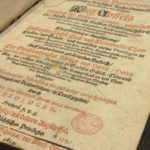In August of 1530 Christians leaders from around what is now Germany in the Holy Roman Empire gathered for the Diet of August, that is, the Meeting at Augsburg. Representatives of the Holy Roman Empire, the Roman Catholic Church and Protestants assembled with the single goal of finding common ground and maintaining the unity of the church.

They faced external pressures for unity too. The advance of militant Islam into Europe required a unified response. Unity was the objective but that unity was not achieved among any of the groups.
Conspicuous by his absence was Dr. Martin Luther, who remained under the ban. In his place was the scholar Philip Melanchthon. Melanchthon served as the primary author of a document that detailed what the Protestants claimed was true theology.
The Roman Catholic Church representatives rejected this document out of hand. The Swiss Protestants also refused to sign it signally their acceptance.
Nevertheless the document continued to gain acceptance among “Lutherans” and was known as the Augsburg Confession. It became and still is the standard for defining the essential doctrines of the Lutheran interpretation of the Christian faith. The constitution of the AALC and of Emmanuel Lutheran Church both call out the Augsburg Confession as our standard statement of doctrinal truth.

Of course the Augsburg Confession stands under the final authority of Holy Scripture, the Word of God, and the “norming norm” for all doctrine, faith and life.
A copy of the Augsburg Confession is in our Church library and in Pastor Tim’s library for your perusal.
This year marks the 500th anniversary of the Reformation, identified as that time when Luther nailed the 95 Theses to the door of the Wittenberg Church. Please take a moment to review the large display copy of the 95 Theses on the wall of the Fellowship Hall.
We send our thanks to DeWayne Kalista for donating this copy.
Pastor Tim Cartwright
